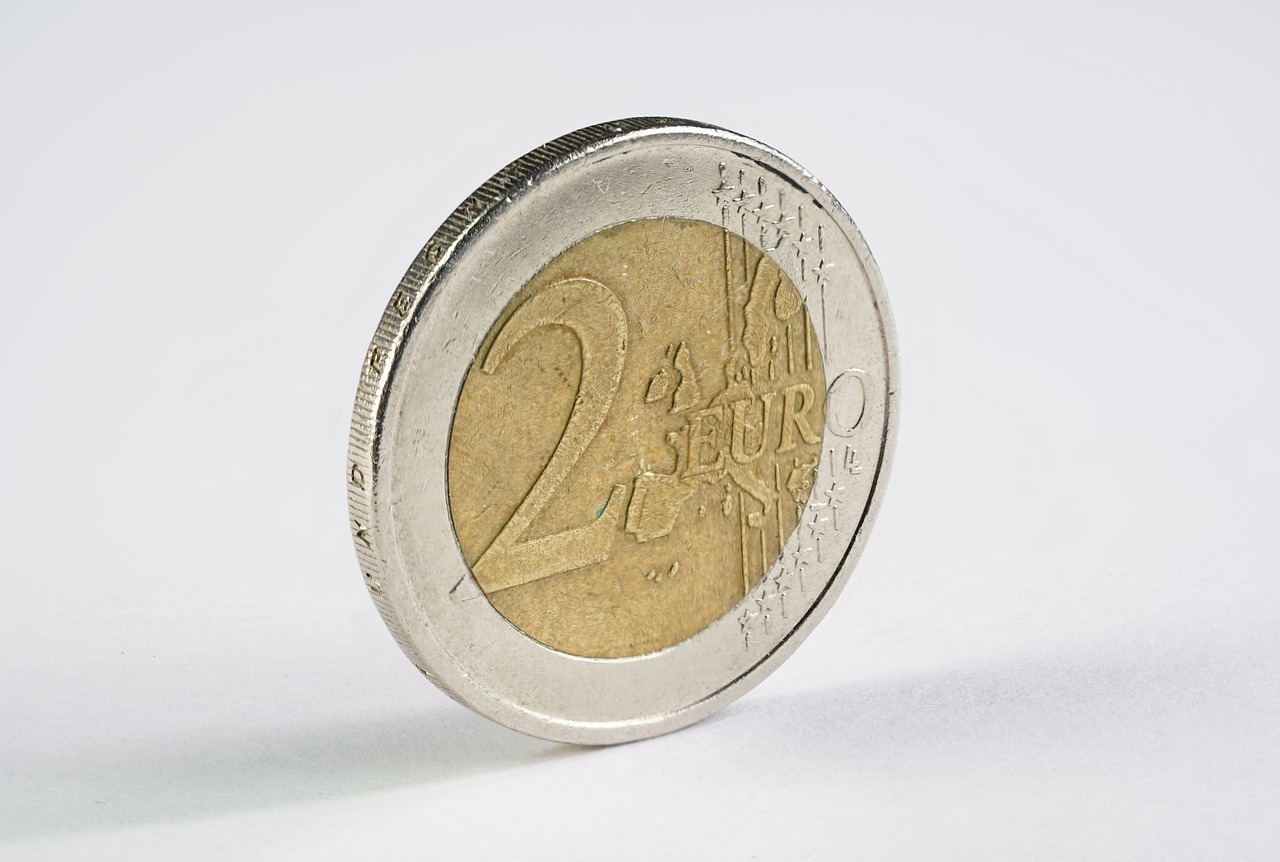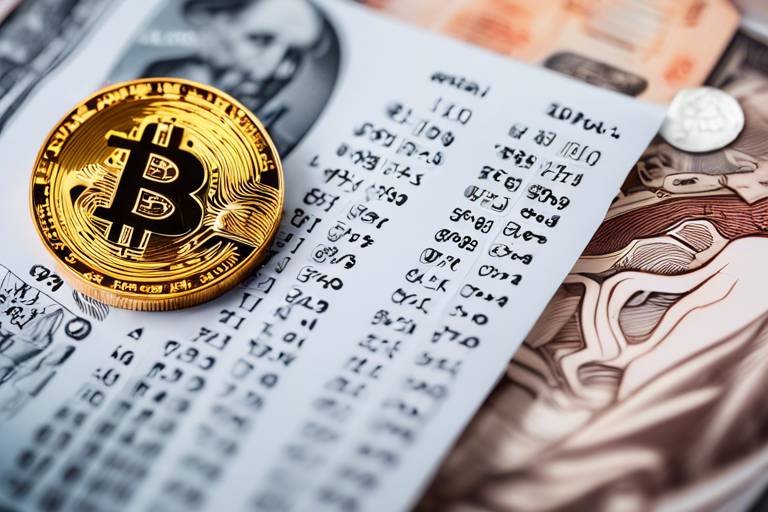Understanding the Effects of Currency Fluctuations on Crypto
In today's fast-paced financial landscape, the world of cryptocurrency is as thrilling as it is unpredictable. Just like a rollercoaster, the ride can be exhilarating, but it can also leave you feeling a bit queasy. One of the key factors contributing to this volatility is the fluctuations in traditional fiat currencies. As these currencies rise and fall, they create ripples in the cryptocurrency market, influencing everything from investor behavior to market adoption rates. So, how do these currency fluctuations really impact the crypto world? Buckle up, because we're about to dive deep into this fascinating relationship!
To understand how currency fluctuations affect cryptocurrencies, we first need to explore the intricate dance between fiat and digital currencies. Fiat currencies, like the US dollar or the euro, are government-issued and can be influenced by various factors, including economic policies, inflation rates, and geopolitical events. When the value of a fiat currency changes, it can have a direct impact on the price of cryptocurrencies. For instance, if the dollar weakens, investors may flock to cryptocurrencies as a hedge against inflation, driving up their prices. Conversely, a strong dollar might lead to decreased interest in crypto, causing prices to drop.
Market volatility is the name of the game in the crypto world. When fiat currencies fluctuate, they can create a ripple effect that leads to increased volatility in the cryptocurrency market. This volatility can significantly impact investor sentiment. Imagine you're watching a sports game where the score changes every few minutes; it creates a sense of urgency and excitement. Similarly, when investors see their crypto investments swinging wildly in response to fiat currency changes, it can lead to panic selling or impulsive buying, which only adds to the market's instability.
So, how can investors protect themselves from the unpredictable nature of currency fluctuations? Implementing effective risk management strategies is crucial. Here are some strategies that can help:
- Diversification: Spreading investments across various cryptocurrencies can reduce the risk associated with any single asset.
- Hedging: Using financial instruments like derivatives or stablecoins can help offset potential losses from currency fluctuations.
Diversification is like not putting all your eggs in one basket. By investing in a mix of cryptocurrencies, you can cushion your portfolio against the shocks of market volatility. For example, if you invest in both Bitcoin and Ethereum, a downturn in one may be offset by stability or growth in the other. This approach allows you to manage risk while still participating in the potential upside of various digital currencies.
Another effective way to mitigate risks is through hedging. This involves using financial instruments to counterbalance potential losses. For instance, stablecoins, which are pegged to fiat currencies, can provide a safe haven during turbulent market conditions. Additionally, derivatives like options and futures contracts allow investors to lock in prices and protect against unfavorable movements in the market.
The relationship between currency fluctuations and the adoption of cryptocurrencies is significant. As fiat currencies exhibit instability, more consumers and businesses may turn to cryptocurrencies as an alternative. This shift can lead to increased adoption rates, as individuals seek to escape the volatility of traditional currencies. However, if the crypto market becomes too volatile itself, it may deter potential users, creating a double-edged sword that stakeholders must navigate carefully.
Currency fluctuations are not just random events; they are often influenced by broader global economic factors. Understanding these factors is essential for grasping the complex dynamics between fiat and crypto. Economic indicators such as inflation rates, interest rates, and geopolitical events all play a role in shaping currency values, which in turn affect the cryptocurrency market.
Inflation is a key player in the currency fluctuation game. When inflation rises, the purchasing power of fiat currencies decreases, which may push investors towards cryptocurrencies as a store of value. Similarly, interest rates can influence investor behavior; lower interest rates may encourage borrowing and spending, potentially driving up demand for cryptocurrencies as an alternative investment.
Geopolitical events, such as elections, trade wars, and conflicts, can lead to sudden and significant currency fluctuations. These events create uncertainty, prompting investors to seek safe havens in cryptocurrencies. However, this can also lead to increased volatility in the crypto market itself, as reactions to these events can be swift and unpredictable.
Q: How do currency fluctuations affect cryptocurrency prices?
A: Currency fluctuations can lead to increased demand for cryptocurrencies as investors seek alternatives to unstable fiat currencies, impacting their prices.
Q: What are some effective risk management strategies for crypto investors?
A: Strategies such as diversification and hedging can help mitigate risks associated with currency fluctuations in the cryptocurrency market.
Q: How do global economic factors influence currency fluctuations?
A: Factors like inflation, interest rates, and geopolitical events can all impact the stability of fiat currencies, which in turn affects the cryptocurrency market.

The Relationship Between Fiat and Crypto
The connection between traditional fiat currencies and cryptocurrencies is both intricate and fascinating. As the world becomes more digital, understanding this relationship is crucial for investors and enthusiasts alike. At its core, fiat currencies, which are government-issued and not backed by a physical commodity, hold significant sway over the cryptocurrency market. When the value of a fiat currency fluctuates, it can create ripples that affect the prices of cryptocurrencies. For instance, if the US dollar weakens, investors may turn to cryptocurrencies as a hedge against inflation, thereby driving up their prices. Conversely, a strong dollar might lead to a decrease in crypto investments as people feel more secure in traditional assets.
The interaction between fiat and crypto can be likened to a dance—each partner influences the other's movements. For example, when a country experiences economic instability, its fiat currency may depreciate, prompting citizens to seek alternative stores of value, like Bitcoin or Ethereum. This shift can lead to increased demand for cryptocurrencies, resulting in price surges. On the flip side, if cryptocurrencies gain significant traction and start to be seen as viable alternatives to fiat, it may prompt governments to tighten regulations or implement measures to stabilize their currencies, creating a tug-of-war scenario. It's a complex relationship that demands attention.
Furthermore, the liquidity of fiat currencies plays a vital role in the cryptocurrency market. The ease with which fiat can be converted into crypto and vice versa is a significant factor influencing market dynamics. For example, exchanges that facilitate seamless transactions between fiat and crypto can enhance investor confidence and encourage greater participation in the market. Conversely, if conversion processes are cumbersome or costly, it may deter potential investors from entering the crypto space.
To illustrate the impact of fiat currency fluctuations on crypto prices, consider the following table, which demonstrates how changes in the value of the Euro have affected Bitcoin prices over a specific period:
| Date | Euro to USD Exchange Rate | Bitcoin Price in USD |
|---|---|---|
| Jan 1, 2023 | 1.12 | $40,000 |
| Mar 1, 2023 | 1.10 | $42,500 |
| May 1, 2023 | 1.15 | $38,500 |
| July 1, 2023 | 1.08 | $45,000 |
As evidenced by the table, fluctuations in the Euro's exchange rate directly correlate with Bitcoin's price movements. Investors need to stay informed about these changes to make strategic decisions. It's essential to recognize that while cryptocurrencies offer unique advantages, they are still deeply intertwined with the traditional financial system. This relationship underscores the importance of monitoring fiat currency trends and understanding their potential impact on the crypto landscape.
In conclusion, the relationship between fiat and crypto is a dynamic one, influenced by various economic factors and investor behaviors. As cryptocurrencies continue to gain popularity, their interaction with traditional currencies will likely evolve, presenting both opportunities and challenges for investors. Staying abreast of these changes will be crucial for anyone looking to navigate the exciting yet volatile world of digital currencies.

Market Volatility and Investor Behavior
The world of cryptocurrency is often likened to a rollercoaster ride, where the highs can be exhilarating and the lows can be downright terrifying. This market volatility is largely influenced by fluctuations in traditional fiat currencies, which can lead to significant swings in crypto prices. Investors, like seasoned thrill-seekers, must navigate these ups and downs with caution and strategy. But what exactly drives this volatility, and how does it shape investor behavior?
When the value of a fiat currency changes, it doesn't just affect the purchasing power of that currency; it also ripples through the crypto market. For instance, if a major fiat currency experiences a sudden drop in value due to economic instability or political turmoil, investors may flock to cryptocurrencies as a safe haven, driving prices up. Conversely, a strengthening fiat currency can lead to a decrease in crypto demand, causing prices to plummet. This dynamic interplay creates a market environment where prices can swing wildly in a matter of hours, or even minutes.
Investor sentiment plays a crucial role in this volatility. When prices are soaring, excitement and optimism can lead to a herd mentality, where investors rush to buy, fearing they might miss out on potential gains. However, this can quickly turn into panic selling when prices begin to fall. The psychological factors at play are immense, and often, investors' decisions are driven more by emotion than by rational analysis. This is where understanding market trends and investor psychology becomes essential.
Moreover, the impact of social media and news cannot be overstated. A single tweet from a prominent figure or a breaking news story can send shockwaves through the market, leading to rapid price changes. Investors are constantly on edge, monitoring news feeds and social platforms for the latest updates, which can exacerbate market volatility. This environment of uncertainty often leads to a cycle of fear and greed, with investors oscillating between optimism and pessimism.
To illustrate the direct correlation between market volatility and investor behavior, consider the following table:
| Market Condition | Investor Reaction | Price Movement |
|---|---|---|
| Fiat Currency Decline | Increased investment in crypto | Prices rise |
| Fiat Currency Strengthening | Sell-off of cryptocurrencies | Prices fall |
| Negative News | Panic selling | Sharp price drop |
| Positive Market Trends | Buying frenzy | Sharp price increase |
As we delve deeper into the psychology of investors, it becomes clear that many are not just passive observers but active participants who react to market signals. This behavior can create a feedback loop where rising prices attract more investors, which in turn drives prices even higher until a tipping point is reached. At that point, any negative news or event can trigger a mass exit, leading to significant losses for those caught in the frenzy.
Understanding these patterns is essential for anyone looking to invest in cryptocurrencies. By recognizing how market volatility influences investor behavior, individuals can develop more informed strategies to navigate this unpredictable landscape. Whether through technical analysis, staying updated on global economic trends, or simply maintaining a level head during turbulent times, savvy investors can find ways to thrive even in the most volatile markets.
- What causes market volatility in cryptocurrencies? Market volatility is primarily driven by changes in fiat currencies, investor sentiment, news events, and social media influence.
- How can investors manage risk in a volatile market? Investors can manage risk through diversification, setting stop-loss orders, and staying informed about market trends.
- Why do investors react emotionally to market changes? Emotional reactions are often rooted in fear of loss or the desire for profit, leading to impulsive decision-making.

Risk Management Strategies
When it comes to investing in cryptocurrencies, the landscape can often feel like a roller coaster ride, with prices soaring one moment and plummeting the next. This volatility is largely influenced by currency fluctuations, making risk management strategies not just beneficial but essential for any investor looking to safeguard their assets. So, how can you effectively manage risk in this unpredictable market? Let's dive into some practical approaches that can help you navigate these turbulent waters.
First and foremost, diversification is a fundamental strategy that every investor should consider. By spreading your investments across various cryptocurrencies and even other asset classes, you can reduce the impact of a poor-performing asset on your overall portfolio. Think of it like not putting all your eggs in one basket; if one egg cracks, you still have others to rely on. A well-diversified portfolio might include a mix of established cryptocurrencies like Bitcoin and Ethereum, along with some altcoins that have growth potential. This way, if the value of one currency dips due to a fluctuation in fiat currencies, your entire investment won’t suffer dramatically.
Another effective strategy is to utilize hedging options. Hedging involves taking an offsetting position in a related asset to mitigate potential losses. For instance, you can use derivatives such as options and futures contracts to protect your investments against adverse price movements. Additionally, stablecoins—cryptocurrencies pegged to stable assets like the US dollar—can serve as a safe haven during times of high volatility. By converting a portion of your crypto holdings into stablecoins, you can maintain liquidity while minimizing exposure to sudden market shifts.
Moreover, setting stop-loss orders is a practical way to manage risk. A stop-loss order automatically sells your cryptocurrency when it reaches a certain price, limiting your losses in the event of a downturn. This strategy requires careful consideration of your risk tolerance and market conditions, but it can provide peace of mind knowing that you have a safety net in place. Remember, it's crucial to regularly review and adjust your stop-loss levels based on market trends and your investment goals.
Lastly, staying informed about market trends and global economic factors is vital. Understanding how currency fluctuations impact the crypto market can help you make more informed decisions. For example, if you notice that a particular fiat currency is experiencing inflation, it might be a signal to reassess your crypto investments. By keeping an eye on news and developments in both the fiat and crypto worlds, you can better anticipate potential risks and adjust your strategies accordingly.
In summary, managing risk in the cryptocurrency market requires a combination of diversification, hedging, strategic selling, and staying informed. By employing these strategies, you can better navigate the unpredictable nature of currency fluctuations and protect your investments from unnecessary losses.
- What is risk management in cryptocurrency? Risk management in cryptocurrency involves strategies and techniques to minimize potential losses and protect investments from market volatility.
- How can diversification help reduce risk? Diversification spreads investments across different assets, reducing the impact of any single asset's poor performance on the overall portfolio.
- What are stop-loss orders? Stop-loss orders are automatic sell orders that trigger when a cryptocurrency reaches a specified price, helping to limit losses.
- What are stablecoins? Stablecoins are cryptocurrencies pegged to stable assets like fiat currencies, providing a less volatile option for investors.

Diversification Techniques
Diversification is a crucial strategy for any investor looking to safeguard their portfolio against the unpredictable tides of currency fluctuations in the cryptocurrency market. By spreading investments across various assets, investors can minimize risks and enhance potential returns. Think of it like a well-balanced diet; if you only eat one type of food, you risk missing out on essential nutrients. Similarly, relying solely on one cryptocurrency can expose you to significant risks. So, how can you effectively diversify your crypto investments?
One effective technique is to invest in a mix of different cryptocurrencies. While Bitcoin and Ethereum might dominate the headlines, there are thousands of altcoins with unique use cases and potential for growth. By allocating a portion of your portfolio to lesser-known cryptocurrencies, you can tap into emerging trends and technologies. For instance, projects focused on decentralized finance (DeFi) or non-fungible tokens (NFTs) could offer substantial returns if they gain traction.
Another method is to consider geographical diversification. The crypto market is global, and different regions may experience varying levels of adoption and regulatory environments. By investing in cryptocurrencies that are popular in different parts of the world, you can shield your portfolio from localized economic downturns. For example, while the U.S. market may be experiencing volatility, other countries might be seeing a surge in crypto adoption, providing a buffer against losses.
Furthermore, incorporating traditional assets into your portfolio can also enhance diversification. This could mean holding a mix of stocks, bonds, and even commodities alongside your cryptocurrencies. By doing this, you can create a more resilient portfolio that can withstand the shocks of currency fluctuations. The key is to find a balance that aligns with your risk tolerance and investment goals.
Finally, consider the use of automated tools and platforms that offer diversified portfolios. Many crypto exchanges and investment platforms provide options for investors to create a basket of cryptocurrencies based on their risk preferences. These tools often employ algorithms to manage and rebalance your investments, making it easier for you to stay diversified without constantly monitoring the market.
In summary, diversification in cryptocurrency investments is about being strategic and proactive. By investing in a variety of cryptocurrencies, considering geographical factors, incorporating traditional assets, and utilizing automated platforms, you can build a robust portfolio that can weather the storms of currency fluctuations. Remember, just like in life, it's often the combination of different elements that leads to the most fulfilling outcomes.
- What is diversification in cryptocurrency?
Diversification in cryptocurrency involves spreading your investments across different cryptocurrencies and asset classes to reduce risk and enhance potential returns. - Why is diversification important?
Diversification helps mitigate risks associated with market volatility and currency fluctuations, providing a buffer against losses. - How can I diversify my crypto portfolio?
You can diversify by investing in a mix of different cryptocurrencies, considering geographical factors, incorporating traditional assets, and utilizing automated investment tools. - Is it better to invest in Bitcoin or altcoins?
It depends on your risk tolerance and investment goals. While Bitcoin is often considered a safer bet, altcoins can offer significant growth potential.

Hedging Options
When it comes to investing in cryptocurrencies, the unpredictable nature of currency fluctuations can send shivers down the spine of even the most seasoned investors. But fear not! There are effective that can help you shield your investment from the stormy seas of market volatility. Think of these strategies as your life jackets in the turbulent waters of crypto trading.
One of the most popular hedging options is the use of derivatives. These financial instruments derive their value from an underlying asset, in this case, cryptocurrencies. By utilizing derivatives such as futures and options, investors can lock in prices and minimize potential losses. For instance, if you anticipate a decline in the value of Bitcoin, you can enter into a futures contract that allows you to sell at a predetermined price. This way, if the market takes a nosedive, you can still sell at the higher price you locked in, effectively cushioning your portfolio from losses.
Another effective hedging strategy involves the use of stablecoins. These cryptocurrencies are pegged to stable assets, such as the US dollar, which means they tend to maintain a consistent value. By converting a portion of your volatile crypto holdings into stablecoins during periods of uncertainty, you can safeguard your investments against sudden dips. This strategy not only provides stability but also allows for quick re-entry into the market when conditions improve.
Moreover, diversification plays a crucial role in your hedging strategy. By spreading your investments across various cryptocurrencies and other asset classes, you can reduce the overall risk associated with currency fluctuations. For example, if you have a mix of Bitcoin, Ethereum, and stablecoins, a decline in one asset might be offset by gains in another. This not only protects your investment but also enhances your potential for profit.
It's important to note that while hedging can significantly reduce risk, it doesn't eliminate it entirely. The crypto market is inherently volatile, and unexpected events can still lead to losses. Therefore, staying informed about market trends and continuously adjusting your hedging strategies is vital. In the end, think of your hedging options as part of a broader investment strategy—a way to navigate the unpredictable currents of the cryptocurrency world.
- What are derivatives in cryptocurrency?
Derivatives are financial contracts whose value is derived from the performance of an underlying asset, such as Bitcoin or Ethereum. They can be used for hedging against price fluctuations. - How do stablecoins work?
Stablecoins are cryptocurrencies designed to maintain a stable value by pegging them to a reserve of assets, like the US dollar. They provide a safe haven during market volatility. - Can hedging completely eliminate risk?
No, while hedging can reduce risk, it cannot eliminate it entirely. The crypto market is unpredictable, and unexpected events can still lead to losses. - How can I diversify my cryptocurrency investments?
Diversification involves spreading your investments across different cryptocurrencies and asset classes to reduce risk. For example, you could invest in Bitcoin, Ethereum, and stablecoins.

Impact on Adoption Rates
The relationship between currency fluctuations and the adoption rates of cryptocurrencies is a fascinating and complex one. As traditional fiat currencies experience volatility, the perception and utility of cryptocurrencies can shift dramatically. When fiat currencies weaken, many individuals and businesses seek refuge in alternative assets, often turning to cryptocurrencies as a hedge against economic uncertainty. This creates a unique environment where the adoption of digital currencies can surge, especially in regions facing hyperinflation or economic instability.
For instance, consider countries like Venezuela and Zimbabwe, where the local currency has plummeted in value. In such scenarios, cryptocurrencies provide a lifeline, allowing people to preserve their wealth and transact without the fear of their money losing value overnight. This phenomenon illustrates how currency fluctuations can drive cryptocurrency adoption in desperate economic situations. The allure of decentralized finance and the potential for financial sovereignty become particularly appealing when traditional financial systems falter.
Moreover, the perception of cryptocurrencies can also be influenced by how fiat currencies perform on the global stage. When major currencies like the US dollar or Euro experience significant swings, it can lead to a ripple effect in the crypto market. Investors may view cryptocurrencies as not just speculative assets but as legitimate alternatives for transactions and savings. This shift in perspective can lead to increased interest from both retail and institutional investors, further accelerating adoption rates.
However, it's not all sunshine and rainbows. The volatility that comes with currency fluctuations can also create hesitation among potential users. Many people are still wary of cryptocurrencies due to their price instability. For example, if someone wants to buy a product priced in Bitcoin, the value of Bitcoin could change dramatically within hours, leading to uncertainty about the actual cost. This uncertainty can deter businesses from accepting cryptocurrencies as a payment method, which in turn stifles broader adoption.
In summary, the impact of currency fluctuations on the adoption rates of cryptocurrencies is a double-edged sword. While they can drive adoption in times of economic distress, they can also create barriers that prevent widespread use. Understanding this dynamic is crucial for anyone looking to navigate the ever-evolving landscape of digital currencies. As the world becomes more interconnected, the interplay between fiat and crypto will continue to shape how we think about money and value.
- How do currency fluctuations affect cryptocurrency prices?
Currency fluctuations can lead to increased volatility in cryptocurrency prices as investors react to changes in fiat values, often causing rapid price movements in the crypto market. - Can cryptocurrencies help in countries with unstable currencies?
Yes, cryptocurrencies can provide a stable alternative for individuals in countries facing hyperinflation or economic instability, allowing them to preserve their wealth. - What are the risks associated with investing in cryptocurrencies?
The primary risks include market volatility, regulatory changes, and the potential for loss due to hacking or fraud.

Global Economic Factors
The world of finance is a complex web, and at the heart of it lies the intricate dance between and currency fluctuations. Understanding this relationship is crucial for anyone delving into the cryptocurrency market. Currency values don’t just fluctuate randomly; they are influenced by a myriad of economic indicators, including inflation rates, interest rates, and geopolitical events. These factors can create ripples that affect not only fiat currencies but also the digital currencies that many investors are turning to as alternatives. So, how do these global economic factors come into play?
To start, let's consider inflation and interest rates. When inflation rises, the purchasing power of fiat currencies diminishes, leading investors to seek alternative stores of value, such as cryptocurrencies. For instance, if a country experiences high inflation, its currency might lose value rapidly, prompting its citizens to invest in Bitcoin or other stablecoins as a hedge against their local currency's decline. On the flip side, when interest rates are low, borrowing becomes cheaper, which can lead to increased investment in riskier assets, including cryptocurrencies. This relationship can be summarized in the following table:
| Economic Factor | Effect on Fiat Currency | Effect on Cryptocurrency |
|---|---|---|
| High Inflation | Decreases value | Increases demand as a hedge |
| Low Interest Rates | Encourages borrowing | Increases investment in crypto |
Next, we have geopolitical events, which can create sudden and significant currency fluctuations. Imagine a country facing political unrest or a major conflict; this uncertainty can lead to a rapid depreciation of its currency. Investors, in response, might flock to cryptocurrencies, viewing them as a safe haven. The volatility that arises from such events can be a double-edged sword; while it may present opportunities for profit, it can also lead to increased market instability. Historical examples abound, where elections, trade wars, or even natural disasters have sparked dramatic shifts in currency values, impacting the crypto market in the process.
In addition to these factors, global economic trends such as trade agreements, economic sanctions, and changes in government policies can further influence currency stability. For example, a new trade deal might strengthen a country's currency, encouraging investment in its local assets, while a sanction could do the opposite. The interconnectedness of our global economy means that what happens in one part of the world can have far-reaching consequences for currencies and, consequently, for cryptocurrencies.
Ultimately, understanding these global economic factors is essential for investors looking to navigate the often turbulent waters of the cryptocurrency market. By keeping an eye on inflation trends, interest rate changes, and geopolitical events, investors can better position themselves to make informed decisions. As the cryptocurrency market continues to evolve, being proactive and aware of these external influences will be key to mitigating risks and capitalizing on opportunities.
- What are the main factors that affect currency fluctuations? Currency fluctuations are primarily influenced by inflation rates, interest rates, and geopolitical events.
- How do geopolitical events impact the cryptocurrency market? Geopolitical events can lead to sudden currency depreciation, prompting investors to seek refuge in cryptocurrencies.
- What role does inflation play in cryptocurrency investments? High inflation can decrease the value of fiat currencies, making cryptocurrencies more appealing as a hedge against loss of purchasing power.

Inflation and Interest Rates
When we talk about inflation and interest rates, we’re diving into two of the most significant economic indicators that can shake up the financial world, including the cryptocurrency market. Inflation refers to the rate at which the general level of prices for goods and services rises, leading to a decline in purchasing power. Conversely, interest rates are the cost of borrowing money, which central banks manipulate to control economic activity. So, how do these two factors interact, and what does it mean for cryptocurrencies?
To begin with, rising inflation often prompts central banks to increase interest rates to cool down an overheating economy. This relationship can have a profound impact on both fiat currencies and cryptocurrencies. For instance, when interest rates rise, borrowing becomes more expensive, which can lead to reduced spending and investment. This shift can cause a ripple effect in the cryptocurrency market as investors may seek safer, interest-bearing assets instead of volatile digital currencies.
Moreover, the correlation between inflation and cryptocurrency values can be quite complex. Many investors turn to cryptocurrencies, viewing them as a hedge against inflation. They believe that, unlike fiat currencies that can be printed in excess, cryptocurrencies like Bitcoin have a capped supply, making them more attractive during inflationary periods. This perception can lead to increased demand for cryptocurrencies, driving up their prices even as traditional markets may be suffering.
Let’s break down the interaction between inflation, interest rates, and cryptocurrencies:
| Factor | Impact on Fiat | Impact on Cryptocurrency |
|---|---|---|
| Rising Inflation | Decreased purchasing power, potential for higher interest rates | Increased demand as a hedge, potential price surge |
| Increasing Interest Rates | Higher borrowing costs, reduced consumer spending | Potential decrease in investment, volatility in prices |
In essence, when inflation rises, investors may flock to cryptocurrencies as a means to preserve their wealth. However, if interest rates climb too high, it could deter new investments in the crypto space, leading to increased market volatility. It’s a delicate balancing act that investors must navigate. As they weigh the pros and cons of holding digital assets versus traditional investments, the broader economic climate plays a pivotal role in shaping their decisions.
Furthermore, this dynamic isn’t just theoretical; it has real-world implications. For example, during periods of hyperinflation in certain countries, we’ve seen a surge in cryptocurrency adoption as people seek alternatives to their devaluing local currencies. Countries like Venezuela and Zimbabwe have witnessed a dramatic rise in crypto usage as citizens look for stability amidst financial chaos. This phenomenon highlights how inflation and interest rates can drive people towards cryptocurrencies, altering the landscape of digital finance.
In conclusion, the relationship between inflation, interest rates, and cryptocurrencies is intricate and ever-evolving. As investors, understanding this relationship can help us make informed decisions. It’s not just about watching the price charts; it’s about keeping an eye on the economic indicators that influence those prices. The world of finance is full of surprises, and being prepared for the unexpected can make all the difference in your investment strategy.

Geopolitical Events
Geopolitical events are like the unpredictable ripples in a pond; they can start as a small disturbance but quickly escalate into massive waves that affect various markets, including cryptocurrencies. When a country faces political unrest, economic sanctions, or military conflicts, the value of its fiat currency often plummets. This decline can lead to a flight of capital as investors seek safer havens, which often includes turning to cryptocurrencies. For instance, during times of uncertainty, such as the Brexit vote or the U.S.-China trade tensions, many investors have turned to Bitcoin and other digital currencies as a hedge against instability.
Furthermore, the correlation between geopolitical events and currency fluctuations can create a domino effect in the crypto market. When a fiat currency loses value, it can lead to increased demand for cryptocurrencies, pushing their prices up. However, this can also result in heightened volatility as traders react to news and rumors, leading to rapid price changes. The crypto market, known for its inherent volatility, can become even more unstable when these external factors come into play.
To illustrate this relationship, consider the following table, which summarizes recent geopolitical events and their impact on cryptocurrency prices:
| Geopolitical Event | Date | Impact on Cryptocurrency |
|---|---|---|
| Brexit Referendum | June 23, 2016 | Bitcoin surged by over 10% in the days following the vote. |
| U.S.-China Trade War | 2018-Present | Increased volatility in crypto markets as investors reacted to tariffs. |
| Russia-Ukraine Conflict | February 2022 | Bitcoin and Ethereum saw significant price increases as investors sought safe havens. |
It's essential to understand that while geopolitical events can create opportunities for profit, they also come with risks. Investors need to stay informed about global events and their potential impacts on both fiat and cryptocurrency markets. This awareness can help them make more informed decisions and better navigate the turbulent waters of crypto investing.
In summary, geopolitical events are crucial in shaping the landscape of cryptocurrency investments. They not only influence fiat currencies but also directly affect the behavior and sentiment of crypto investors. Staying alert to these developments can provide a strategic advantage in the fast-paced world of digital currencies.
- How do geopolitical events affect cryptocurrency prices?
Geopolitical events can lead to currency devaluation, prompting investors to seek alternatives like cryptocurrencies, which can increase their prices. - Are cryptocurrencies a safe haven during geopolitical instability?
While some investors view cryptocurrencies as a safe haven, they are still highly volatile and can be affected by the same geopolitical events. - What should investors do during geopolitical turmoil?
Investors should stay informed, assess their risk tolerance, and consider diversifying their portfolios to mitigate potential losses.
Frequently Asked Questions
- How do currency fluctuations affect the cryptocurrency market?
Currency fluctuations can significantly impact the cryptocurrency market by influencing investor behavior and market volatility. When fiat currencies experience changes in value, it can lead to shifts in the demand for cryptocurrencies, ultimately affecting their prices. For instance, a strong dollar might make crypto investments less appealing, while a weaker dollar could encourage more investment in digital currencies.
- What is the relationship between fiat currencies and cryptocurrencies?
Fiat currencies and cryptocurrencies interact in complex ways. Changes in the value of fiat currencies can directly influence the prices of cryptocurrencies. For example, if a country's currency depreciates, investors might flock to digital currencies as a hedge against inflation, thereby driving up crypto prices. Conversely, if fiat currencies are stable and strong, investors may prefer to hold traditional assets.
- How can investors manage risks associated with currency fluctuations?
Investors can employ several risk management strategies to protect their portfolios from the adverse effects of currency fluctuations. Techniques such as diversification—spreading investments across different assets—and hedging through instruments like derivatives or stablecoins can help mitigate risks. By using these strategies, investors can cushion their portfolios from sudden market shifts.
- What are some effective diversification techniques?
Diversification techniques can include investing in a mix of cryptocurrencies, traditional assets, and even commodities. For example, holding a combination of Bitcoin, Ethereum, and stablecoins can help balance out the risks associated with currency volatility. Additionally, exploring investments in different geographical markets can further reduce exposure to local currency fluctuations.
- What are hedging options available for investors?
Hedging options for investors include using derivatives such as futures and options contracts, which allow them to lock in prices for future transactions. Stablecoins, which are pegged to fiat currencies, can also serve as a safe haven during periods of high volatility. These tools can help investors manage their exposure to price swings in both fiat and cryptocurrencies.
- How do currency fluctuations impact the adoption rates of cryptocurrencies?
Currency fluctuations can greatly influence the adoption rates of cryptocurrencies among consumers and businesses. When fiat currencies are unstable or inflation is high, individuals and companies may seek alternatives like cryptocurrencies for transactions or as a store of value, thus increasing adoption. On the other hand, stable economic conditions may lead to slower adoption rates as people feel less urgency to switch to digital currencies.
- What global economic factors contribute to currency fluctuations?
Several global economic factors contribute to currency fluctuations, including inflation rates, interest rates, and geopolitical events. For example, rising inflation can devalue a currency, prompting investors to seek refuge in cryptocurrencies. Similarly, changes in interest rates can affect capital flow and, consequently, currency value, impacting the cryptocurrency market.
- How do geopolitical events affect currency stability?
Geopolitical events, such as elections, trade wars, or conflicts, can lead to sudden and often unpredictable currency fluctuations. These events create uncertainty, which can shake investor confidence and lead to volatility in both fiat and cryptocurrency markets. As a result, investors may react by reallocating their assets, affecting the overall stability of the crypto market.



















